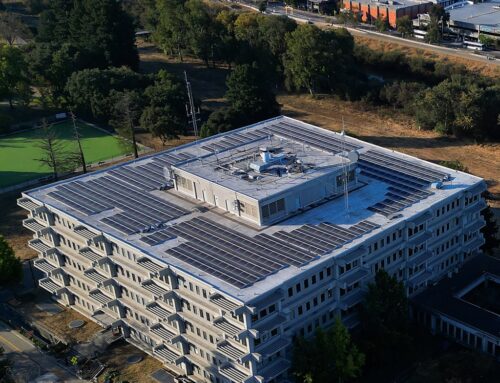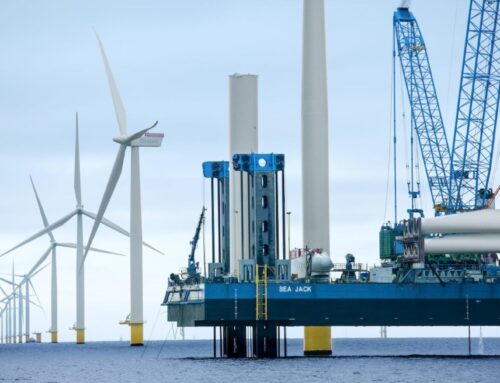Dominion: more gas plants — but still less carbon emissions
October 26, 2024
A Dominion Energy plan that would more than double electricity output could cut its carbon emissions from current levels as it proposes to more than double solar and wind generation, even as it also calls for a 70% increase in natural gas fired generators, a Richmond Times-Dispatch analysis found.
The company’s latest 15-year plan, released this month, is its second “integrated resource plan” in a row that says it will not be able to retire fossil fuel plants by the 2045 deadline set in the Virginia Clean Economy Act if it is to satisfy the law’s requirement that it provides a reliable source of electricity.
People are also reading…
Two of Dominion Energy’s pilot wind turbines are shown 27 miles east of Virginia Beach.
The net effect of building a lot more renewable power sources and a lot more gas-fired plants will be to reduce carbon emissions from nearly 30 million tons in 2023 to somewhere between 19.3 million and 24.6 million metric tons by 2039, Dominion’s plan says. (The difference depends on whether a federal regulation limiting how often gas-fired plants run is in place at that time.)
Dominion’s carbon emissions totaled 57.4 million tons in 2005.
Those numbers are below what the company forecast last year, when its long-term plan for the first time proposed installing new gas-fired plants — basically, the controversial Chesterfield County plant that has stirred vocal local opposition — and said it would not be able to retire other existing plants as earlier plans had outlined.
Dominion’s new plan calls for six more gas-fired plants — two large plants, which use natural gas and waste heat to drive the turbines that spin their electricity generators, three advanced gas turbine plants and one more standard gas turbine plant.
Other power sources
But the plan also calls for a 130% increase in offshore wind power, above the 2,600 megawatts, enough to power 660,000 homes, that Dominion is on track to bring online in 2026.
In addition, the plan calls for adding solar panels capable of generating 12,210 megawatts. That is a big jump up from the 1,573 megawatts now online, the 900 megawatts coming online this year and the more than 2,250 megawatts under development. That’s about 13% more solar than Dominion had been thinking about last year, when it suggested it might not be able to retire fossil fuel plants and would want to build two new gas-fired units.
The plan also looks to a major expansion of battery storage, roughly doubling what it was thinking about last year, to bring power into the system at night, on cloudy days and when the wind falls off in the Atlantic Ocean. Dominion’s $9 billion wind farm is going up 25 miles from the Virginia Beach Oceanfront. In addition, Dominion is looking to bring six small modular nuclear reactors online; these do not emit carbon.
The plan is a rolling update of what the company thinks it will need to do to meet future power demand, based on technology that’s now available or that it is fairly sure will come online. The plan is not a request to the State Corporation Commission to approve any specific project; those are handled on a case-by-case basis with regulators determining if a project is needed and if its costs are a reasonable burden on ratepayers.
One reason for the change is the continuing revision of forecasts for future electricity demand. Two years ago, Dominion forecast 2035 demand at 23,586 megawatts. Last year, it estimated 2035 demand at 38,115. This year’s new look put 2035 demand at 40,279 megawatts. That increase over last year’s forecast is the amount of power equivalent to what more than 540,000 homes now draw at peak periods.
A big part of what has changed in the latest plan is a new calculation of the risk that solar, wind and batteries might not be able to deliver juice when electricity is in peak demand.
That calculation, by PJM Interconnection, which runs the power grid in 13 states from New Jersey south to North Carolina and west to Illinois, is a measure of how many megawatts of power can actually be delivered when demand peaks.
For solar panels, depending on whether they can track the path of the sun or not, PJM figures that will be about 3% to 4% of nominal capacity when demand soars to peak 2035 levels as, for instance, when the sun sets on a hot summer day or before dawn in the winter. That’s a fraction of the 37% to 55% of capacity estimate that Dominion used when completing last year’s long-term plan.
For offshore wind, PJM said utilities should count on tapping more than 20% of nominal capacity — Dominion last year had estimated that rate at 43%.
Control of nuclear, natural gas
Bob Blue, Dominion’s chairman, president and CEO, said: “I totally do understand why, as you’re thinking about these kinds of resources, that you would weight them in the ways that PJM did, because at a specific hour of the day in 2026, I don’t know how cloudy it’s going to be, and I don’t know what the wind is going to be like.”
Blue
He added: “I do know what happens when we operate a nuclear plant or a natural gas plant. We have control over those, so I understand that sort of order of operations.”
Dominion also does not have a lot of control over how much electricity its customers will want — especially in a Virginia where electricity-hungry data centers already account for 20% of the utility’s demand. Electricity supply agreements for data centers now total 5,597 megawatts, with agreements already in hand to boost that to 8,012 megawatts in 2030, and requests for projects demanding an additional 5,835 megawatts already lined up.
The company also did not have much control over a roughly 20-fold increase in the base price of securing power from outside the state in case its own generators fall short of meeting spikes in electric use.
That came during the summer, when PJM held its regular “base residual auction” that sets a benchmark for the transactions that move electricity into and out of various PJM regions. The price reached for the zone Dominion serves hit $446.26 per megawatt-day — that is, $446.26 for enough electricity to supply 250 homes for a day. That’s up from the PJM average of $28.92 per megawatt day at last year’s auction.
In all, Dominion says rising demand, a new evaluation of solar and wind reliability and that surge in the benchmark price of power from other areas does not leave it a lot of choice — which is why its latest plan, unlike versions it’s done in years past, does not propose different mixes of types of generation.
“There are limits, both economic and physical, to everything that we’re trying to do,” Blue said.
“There’s only so much natural gas that we could possibly get into the state of Virginia. There’s only so much we can count on how sunny it’s going to be in the commonwealth or how windy it’s going to be in the commonwealth. And there’s economic limits on everything we do in order to maintain reliability,” he said.
Environmentalists critical
Despite the stepped-up pace of solar and wind developments the new plan proposes, environmentalists said the 70% increase in natural gas-fired generators flouts the Virginia Clean Energy Act and the official state goal of zero carbon emissions from Dominion’s power plants by 2045.
“Dominion is fond of the phrase ‘increasingly clean,’ but here the company publishes a plan that would retire none of its polluting fossil fuel units and instead build nearly 6 gigawatts of new methane gas generation over the next 15 years,” said Peter Anderson, director of State Energy Policy with Appalachian Voices, a nonprofit group that works to protect the land, air and water of central and southern Appalachia.
Dominion’s 2024 integrated resource plan is a look ahead at the next 15 years
“The utility has to get serious about modeling a system that keeps the lights on while actually creating a path to net zero,” he said. “Virginians deserve to know that their monopoly utility is working to build a grid that is compatible with the law and with a sustainable future.”
Walton Shepherd, senior attorney and Virginia director with the Natural Resources Defense Council, said that while Dominion is caught in a squeeze between rising demand and increasing challenges to win local approval of solar facilities, its plan gives short shrift to the impact of expanded energy efficiency efforts and modernization of the electric grid.
“There are legitimate challenges that must be accounted for by all policymakers, if we are to thoughtfully decarbonize our economy in an orderly way,” Shepherd said.
“Data center load growth is a cold reality,” he said, while denials of permits to build solar farms and efforts to speed PJM’s approval of requests to connect renewable plans to the 13-state grid have not yet borne fruit.
“Taken together, it is fair to say that Virginia is in a bit of a pickle,” Shepherd said. Under the Virginia Clean Economy Act, the state aims to slash carbon emissions, “yet demand points up, all while cheap solar energy additions are stuck right around the middle.”
But programs to encourage ratepayers to use power when it’s easier for Dominion to meet demand — overnight, for instance, when charging electric vehicles — and to help people and businesses reduce power use, for instance, by better insulating houses or buying appliances designed to use less electricity, have more potential to slow the surging demand for electricity, he said.
“Dominion cannot simply build its way out of either load growth or statutory carbon limits,” he said, referring to the Virginia Clean Economy Act.
PHOTOS: Dominion’s offshore wind turbines
The turbines Dominion currently operates are part of a pilot project off Virginia Beach.
Turbines off Virginia Beach are part of Dominion Energy’s pilot program. The utility seeks to build a 176-turbine wind farm.
Dominion Energy built wind turbines off the coast of Virginia Beach as part of a pilot program.
This 2022 image shows a turbine from Dominion Energy’s offshore wind project off Virginia Beach.
This turbine, shown April 11, is part of Dominion Energy’s wind farm pilot project off of Virginia Beach.
Members of the media took a tour to Dominion’s offshore wind farm on April 11. Dominion, which has been operating two turbines about 27 miles east of Virginia Beach since 2020, appears poised to scale up offshore wind dramatically.
Members of the media take a tour to Dominion Energy offshore wind farm on Monday, April 11, 2022 in the Atlantic Ocean near Virginia Beach, Virginia.
Members of the media take a tour to Dominion Energy offshore wind farm on Monday, April 11, 2022 in the Atlantic Ocean near Virginia Beach, Virginia.
Members of the media took a tour to the offshore wind farm in the Atlantic Ocean near Virginia Beach on April 11.
Dave Ress (804) 649-6948
#lee-rev-content { margin:0 -5px; }
#lee-rev-content h3 {
font-family: inherit!important;
font-weight: 700!important;
border-left: 8px solid var(–lee-blox-link-color);
text-indent: 7px;
font-size: 24px!important;
line-height: 24px;
}
#lee-rev-content .rc-provider {
font-family: inherit!important;
}
#lee-rev-content h4 {
line-height: 24px!important;
font-family: “serif-ds”,Times,”Times New Roman”,serif!important;
margin-top: 10px!important;
}
@media (max-width: 991px) {
#lee-rev-content h3 {
font-size: 18px!important;
line-height: 18px;
}
}
Search
RECENT PRESS RELEASES
Related Post



